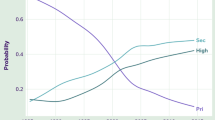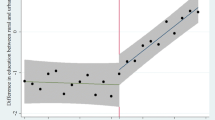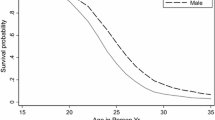Abstract
A rapid rise in women’s education levels, an increase in the age at marriage and an increase in the age at which they have their first child are key features of demographic transition in any country. Education is considered to be an essential component in this process because increases in educational attainment are likely to significantly affect both age at marriage and the duration between marriage and first birth - in particular increasing both the age at marriage and the time to first child. This paper uses individual level unit record data from Pakistan to examine the effect of education on the age at marriage and on the duration between marriage and first birth. We jointly estimate educational attainment, age at marriage and duration between marriage and first birth allowing for household level unobserved heterogeneity. We find that educational attainment increases the age at marriage but does not have a statistically significant effect on the duration between marriage and first birth. However, there is a threshold level of education that must be attained before educational attainment starts having an effect on the hazard of marriage.
Similar content being viewed by others
References
Anderson, K. H., Hill, M. A. and Butler, J. S. (1987), ‘Age at Marriage in Malaysia: A Hazard Model on Marriage Timing’, Journal of Development Economics, 26(2), pp. 223–234.
Becker, G. S., (1974), ‘A Theory of Marriage’ in Economics of the Family: Marriage, Children and Human Capital, T. W. Schultz (Ed), Chicago, University of Chicago Press, pp. 299–344.
Caldwell, J. C., Reddy, P. H. and Caldwell, P., (1983), ‘The Causes of Demographic Change in Rural South India: A Micro Approach’, Population and Development Review, 8(4), pp. 689–727.
Caldwell, J. C., (1980), ‘Mass Education as a Determinant of the Timing of Fertility Decline’, Population and Development Review, 62(2), pp. 225–255.
Brien, M. J. and Lillard, L. A., (1994), ‘Education, Marriage, and First Conception in Malaysia’, Journal of Human Resources, 29(4), pp. 1166–1204.
Brien, M. J., Lillard, L. A. and Waite, L. J., (1999), ‘Interrelated Family-Building Behaviors: Cohabitation, Marriage and Non-marital Conception’, Demography, 36(4), pp. 535–551.
Donaldson, P. J. and Nichols, D. J., (1978), ‘The Changing Tempo of Fertility in Korea’, Population Studies, 32(2), pp. 231–250.
Feng, W. and Quanhe, Y., (1996), ‘Age at Marriage and the First Birth Interval: The Emerging Change in Sexual Behavior Among Young Couples In China’, Population and Development Review, 22(2), pp. 299–320.
Gangadharan, L. and Maitra, P., (2001), ‘Two Aspects of Fertility Behaviour in South Africa’, Economic Development and Cultural Change, October. Forthcoming.
Greene, W. H., (1990), Econometric Analysis, Macmillan Publishing Company.
Lillard, L. A., (1993), ‘Simultaneous Equations for Hazards: Marriage Duration and Fertility Timing’, Journal of Econometrics, 56(1–2), pp. 189–217
Lillard, L. A. and Panis, C. W. A., (2000), Applied Maximum Likelihood User’s Guide and Reference Manual, Econware, Inc.
Lillard, L. A and Willis, R. J., (1994), ‘Intergenerational Educational Mobility: Effects of Family and State in Malaysia’, Journal of Human Resources, 29(4), pp. 1126–66.
Lee, S-H., (2000), ‘Demand for Immunization and Child Survival: Evidence from Rural India’, Mimeo, University of Hawaii.
Raut, L. K., (1996), ‘Old-Age Security and Gender Preference Hypothesis: A Duration Analysis of Malaysian Family Life Survey Data’, Journal of Quantitative Economics, 12(1), pp. 81–104.
Rindfuss, R. R. and Morgan, S. P., (1983), ‘Marriage, Sex and the First Birth Interval: The Quiet Revolution in Asia’, Population and Development Review, 9(2), pp. 259–278.
Sathar, Z. A. (1984), ‘Does Female Education Affect Fertility Behaviour in Pakistan?’, Pakistan Development Review, 23(4), pp. 573–590.
Sathar, Z. A. and Casterline, J. B., (1998), ‘The Onset of Fertility Transition in Pakistan’ Population and Development Review, 24(4), pp. 773–796.
Sathar, Z. A. and Kiani, M. F., (1998), ‘Some Consequences of Rising Age at Marriage in Pakistan’, Pakistan Development Review, 37(4), pp. 541–554.
Sathar, Z. A. and Kazi, S., (1989), ‘Female Employment and Fertility: Further Investigation of an Ambivalent Association’, Pakistan Development Review, 28(3), pp. 175–93.
Sathar, Z. A. and Kiani, M F., (1986), ‘Delayed Marriages in Pakistan’, Pakistan Development Review, 24(4).
Subbarao, K. and Raney, L., (1995), ‘Social Gains from Female Education: A Cross-National Study’, Economic Development and Cultural Change, 44(1), pp. 105–128.
World Bank (1995), Pakistan Integrated Household Survey (PIHS) 1995: Basic Information, Poverty and Human Resources Division, World Bank.




